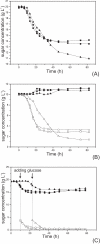An evolved xylose transporter from Zymomonas mobilis enhances sugar transport in Escherichia coli
- PMID: 20003468
- PMCID: PMC2801659
- DOI: 10.1186/1475-2859-8-66
An evolved xylose transporter from Zymomonas mobilis enhances sugar transport in Escherichia coli
Abstract
Background: Xylose is a second most abundant sugar component of lignocellulose besides glucose. Efficient fermentation of xylose is important for the economics of biomass-based biorefineries. However, sugar mixtures are sequentially consumed in xylose co-fermentation with glucose due to carbon catabolite repression (CCR) in microorganisms. As xylose transmembrance transport is one of the steps repressed by CCR, it is therefore of interest to develop a transporter that is less sensitive to the glucose inhibition or CCR.
Results: The glucose facilitator protein Glf transporter from Zymomonas mobilis, also an efficient transporter for xylose, was chosen as the target transporter for engineering to eliminate glucose inhibition on xylose uptake. The evolution of Glf transporter was carried out with a mixture of glucose and xylose in E. coli. Error-prone PCR and random deletion were employed respectively in two rounds of evolution. Aided by a high-throughput screening assay using xylose analog p-nitrophenyl-beta-D-xylopyranoside (pNPX) in 96-well plates, a best mutant 2-RD5 was obtained that contains several mutations, and a deletion of 134 residues (about 28% of total residues), or three fewer transmembrane sections (TMSs). It showed a 10.8-fold improvement in terms of pNPX transport activity in the presence of glucose. The fermentation performance results showed that this mutant improved xylose consumption by 42% with M9 minimal medium containing 20 g L-1 xylose only, while with the mixture sugar of xylose and glucose, 28% more glucose was consumed, but no obvious co-utilization of xylose was observed. Further glucose fed-batch experiments suggested that the intracellular metabolism of xylose was repressed by glucose.
Conclusions: Through random mutagenesis and partial deletion coupled with high-throughput screening, a mutant of the Glf transporter (2-RD5) was obtained that relieved the inhibition of xylose transport by glucose. The fermentation tests revealed that 2-RD5 was advantageous in xylose and glucose uptakes, while no obvious advantage was seen for xylose co-consumption when co-fermented with glucose. Further efforts could focus on reducing CCR-mediated repression of intracellular metabolism of xylose. Glf should also serve as a useful model to further exploit the molecular mechanism of xylose transport and the CCR-mediated inhibition.
Figures





Similar articles
-
Directed evolution of Zymomonas mobilis sugar facilitator Glf to overcome glucose inhibition.J Ind Microbiol Biotechnol. 2022 Apr 14;49(2):kuab066. doi: 10.1093/jimb/kuab066. J Ind Microbiol Biotechnol. 2022. PMID: 34529081 Free PMC article.
-
Expression of a xylose-specific transporter improves ethanol production by metabolically engineered Zymomonas mobilis.Appl Microbiol Biotechnol. 2014 Aug;98(15):6897-905. doi: 10.1007/s00253-014-5812-6. Epub 2014 May 17. Appl Microbiol Biotechnol. 2014. PMID: 24839214
-
An in vivo, label-free quick assay for xylose transport in Escherichia coli.Anal Biochem. 2009 Jul 1;390(1):63-7. doi: 10.1016/j.ab.2009.03.048. Epub 2009 Apr 5. Anal Biochem. 2009. PMID: 19351525
-
The transport and mediation mechanisms of the common sugars in Escherichia coli.Biotechnol Adv. 2014 Sep-Oct;32(5):905-19. doi: 10.1016/j.biotechadv.2014.04.009. Epub 2014 Apr 26. Biotechnol Adv. 2014. PMID: 24780155 Review.
-
Simultaneous consumption of pentose and hexose sugars: an optimal microbial phenotype for efficient fermentation of lignocellulosic biomass.Appl Microbiol Biotechnol. 2010 Nov;88(5):1077-85. doi: 10.1007/s00253-010-2839-1. Epub 2010 Sep 14. Appl Microbiol Biotechnol. 2010. PMID: 20838789 Free PMC article. Review.
Cited by
-
Systems metabolic engineering of microorganisms for natural and non-natural chemicals.Nat Chem Biol. 2012 May 17;8(6):536-46. doi: 10.1038/nchembio.970. Nat Chem Biol. 2012. PMID: 22596205 Review.
-
A Convenient Fluorescence-Based Assay for the Detection of Sucrose Transport and the Introduction of a Sucrose Transporter from Potato into Clostridium Strains.Molecules. 2019 Sep 26;24(19):3495. doi: 10.3390/molecules24193495. Molecules. 2019. PMID: 31561523 Free PMC article.
-
A new screening method for the directed evolution of thermostable bacteriolytic enzymes.J Vis Exp. 2012 Nov 7;(69):4216. doi: 10.3791/4216. J Vis Exp. 2012. PMID: 23169108 Free PMC article.
-
Engineering xylose metabolism for production of polyhydroxybutyrate in the non-model bacterium Burkholderia sacchari.Microb Cell Fact. 2018 May 15;17(1):74. doi: 10.1186/s12934-018-0924-9. Microb Cell Fact. 2018. PMID: 29764418 Free PMC article.
-
Thermodynamic and Kinetic Modeling of Co-utilization of Glucose and Xylose for 2,3-BDO Production by Zymomonas mobilis.Front Bioeng Biotechnol. 2021 Jul 26;9:707749. doi: 10.3389/fbioe.2021.707749. eCollection 2021. Front Bioeng Biotechnol. 2021. PMID: 34381766 Free PMC article.
References
-
- Zverlov VV, Berezina O, Velikodvorskaya GA, Schwarz WH. Bacterial acetone and butanol production by industrial fermentation in the Soviet Union: use of hydrolyzed agricultural waste for biorefinery. Applied Microbiology and Biotechnology. 2006;71:587–597. doi: 10.1007/s00253-006-0445-z. - DOI - PubMed
Publication types
MeSH terms
Substances
LinkOut - more resources
Full Text Sources
Other Literature Sources
Research Materials

